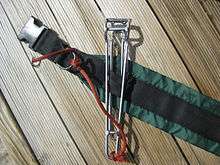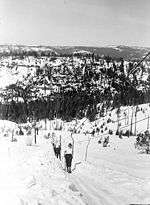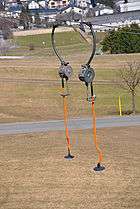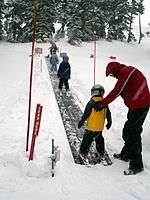Surface lift
A surface lift is a means of cable transport for snow sports in which skiers and snowboarders remain on the ground as they are pulled uphill. Once prevalent, they have been overtaken in popularity by higher-capacity aerial lifts like chairlifts and the gondola lift. Today, surface lifts are most often found on beginner slopes and very small ski areas.[1] They are often utilized at glacier skiing resorts because their supports can be anchored in glacier ice due to the lower forces.
Surface lifts have many disadvantages compared to aerial lifts: they require more passenger skill, the surface must be continuous, they impede skiable terrain, are slow in speed, and of limited capacity. Surface lifts have two advantages over aerial lifts: they can be exited before the lift reaches the top, and they can often continue operating in wind conditions that are too strong for a chairlift.
History
The first surface lift was built in 1908 by German Robert Winterhalder in Schollach/Eisenbach, Hochschwarzwald.[2] A steam-powered toboggan tow, 950 feet (290 m) in length, was built in Truckee, California, in 1910.[3] The first skier-specific tow in North America was apparently installed in 1933 by Alec Foster at Shawbridge in the Laurentians outside Montreal, Quebec.[4]
The Shawbridge tow was quickly copied at Woodstock, Vermont, in New England, in 1934 by Bob and Betty Royce, proprietors of the White Cupboard Inn. Their tow was driven by the rear wheel of a Ford Model A. Wallace "Bunny" Bertram took it over for the second season, improved the operation, renamed it from Ski-Way to Ski Tow,[5] and eventually moved it to what became the eastern fringe of Vermont's major southern ski areas, a regional resort still operating as Suicide Six. Their relative simplicity made tows widespread and contributed to an explosion of the sport in the United States and Europe. Before tows, only people willing to walk uphill could ski. Suddenly relatively nonathletic people could participate, greatly increasing the appeal of the sport. Within five years, more than 100 tow ropes were operating in North America.[6]
Rope tows

A rope tow consists of a cable or rope running through a bullwheel (pulley) at the bottom and one at the top, powered by an engine at one end.
In the simplest case, passengers grab hold of the rope and are pulled along while standing on their skis or snowboards and sliding up the hill. The grade of this style of rope tow is limited by passenger grip strength and the fact that pulleys cannot be used.
A development of the simple rope tow was the handle tow (or pony lift), where plastic or metal handles are permanently attached to the rope. These handles are easier to grip than a rope, making the ski lift easier to ride.
Steeper, faster and longer rope tows have a series of pulleys to support the rope at waist height; hence require the use of some sort of "tow gripper". Several were designed and used in the 1930s and 40s, but the most successful was the "nutcracker" attached to a harness around the hips.[7][8] To this is attached a clamp, much like the nutcracker from which it derives its name, which the rider attaches to the rope. This eliminates the need to hold on to the rope directly. This system was used on many fields worldwide from the 1940s, and remains popular at 'club fields', especially in New Zealand.[9]
T-bar and J-bars

A T-bar or J-bar lift is employed for low-capacity slopes in large resorts and small local areas. It consists of an aerial cable loop running over a series of wheels, powered by an engine at one end. Hanging from the rope are a series of vertical recoiling cables, each attached to a T- or J-shaped bar measuring about a meter in both dimensions. The horizontal bar is placed behind the skier's buttocks or between the snowboarder's legs, and pushes the passengers uphill while they slide across the ground.
The first T-bar lift in the United States was installed in 1940 at the Pico Mountain ski area.[10] It was considered a great improvement over the rope tow. An earlier, potentially home-grown, T-bar was installed at Rib Mountain (now Granite Peak Ski Area), Wisconsin, in 1937.
Invented in the 1930s, J-bars were installed in the 1930s in North America and Australia, with the Ski Hoist at Charlotte Pass in Australia dating from 1938. J-bars have been superseded by T-bars which have twice the capacity. A J-bar closely resembles a T-bar, except that each carrier holds only one passenger.
Platter lift

The platter lift consists of an aerial steel rope loop running over a series of wheels, powered by an engine at one end. Hanging from the rope overhead are equally spaced vertical poles or cables attached to a plastic button or platter that is placed between the skiers legs and pulls the skier uphill. Snowboarders place the platter behind the top of their front leg or in front of their chest under their rear arm and hold it in position with their hands.
One type of platter lift is the detachable surface lift, commonly known as a Poma lift, after the corporation which introduced them.
Whereas many platter lifts are fairly similar to T-bars and J-bars with the stick attached to a spring box by a retractable cord, Pomas have a detachable grip to the tow cable with the button connected to the grip by a semi-rigid pole. Because they are detachable, most Pomas operate at speeds of around 4 metres (13 ft) per second, while platters and T-bars average 2.5 m/s (8.2 ft/s; 5.6 mph). When a Poma's grip attaches to the cable, the passenger's acceleration is lessened by the spring-loaded pole (however, on faster lifts, there can still be quite a jerk when the pole becomes fully extended). The 1,070-metre-long (3,510 ft) Summit Access / Howqua Poma at Mount Buller, Australia, operated at a swift 6.5 m/s (15 mph) when it was built in 1964.[11]
Magic carpet

A magic carpet is a conveyor belt installed at the level of the snow. Some include a canopy or tunnel. Passengers slide onto the belt at the base of the hill and stand with skis or snowboard facing forward. The moving belt pulls the passengers uphill. At the top, the belt pushes the passengers onto the snow and they slide away. They are easier to use than T-bar lifts and Poma lifts.[12]
Magic carpets are limited to shallow grades due to their dependence on friction between the carpet and the bottom of the ski or board. Their slow speed, limited distance, and capacity confines them to beginner and novice areas.
Some of the longest magic carpets are the 560-foot-long (170 m) installation at Stratton Mountain Resort[13] and the nearly 800-foot (240 m) carpet at Buck Hill in Burnsville, Minnesota, which has an overpass over a ski run.[14] The longest carpet lift is a Sunkid carpet lift, 1312-foot-long (400 m), installed at Alpincenter Bottrop, Germany.[15]
References
- ↑ "Technical Information for lifts". SkiLifts.org. Archived from the original on 2007-02-06. Retrieved 2007-04-16.
- ↑ Hochschwarzwald.de: 1. Skilift der Welt in Schollach entdecken (German)
- ↑ Richards, Gordon. "HILLTOP WINTER SPORTS AREA HISTORY". Truckee Donner Historical Society, Inc. Archived from the original on 3 December 2010. Retrieved 16 September 2015.
- ↑ ISHA resources Timeline of Important Ski History Dates
- ↑ Jeremy Davis. "The History of Vermont Skiing: One Hundred Years of Growth". Archived from the original on 2006-10-17. Retrieved 2006-11-16.
- ↑ http://www.knowledgerush.com/kr/encyclopedia/Ski_tow/
- ↑ "The history of the rope tow gripper". eanylodge.org/. Retrieved 14 August 2017.
- ↑ Bousquet Tow Gripper
- ↑ Jeffries, Jane (Jun 5, 2015). "Canterbury: Fields of dreams". New Zealand Herald. Retrieved 4 April 2017.
- ↑ SkiingHistory.org - accessed 25 May 2008
- ↑ Australian ski lift directory - Mt Buller section
- ↑ "Lift Features & Highlights". Rocky Mountain Conveyor & Equipment, Inc. Archived from the original on 2007-08-16. Retrieved 2008-02-06.
- ↑ "America's Longest Magic Carpet Ski Lift and New Snowmaking Coming to Stratton". First Tracks! Online. 30 October 2007. Retrieved 2008-02-06.
- ↑ Bill Hudson (January 1, 2009). "Magic Carpet Ride To The Top Of Buck Hill". WCCO-TV. Retrieved 2009-02-16.
- ↑ "Sunkid | we move - you smile | 2008-09-17 New world record". www.sunkidworld.com. Retrieved 2018-01-16.
